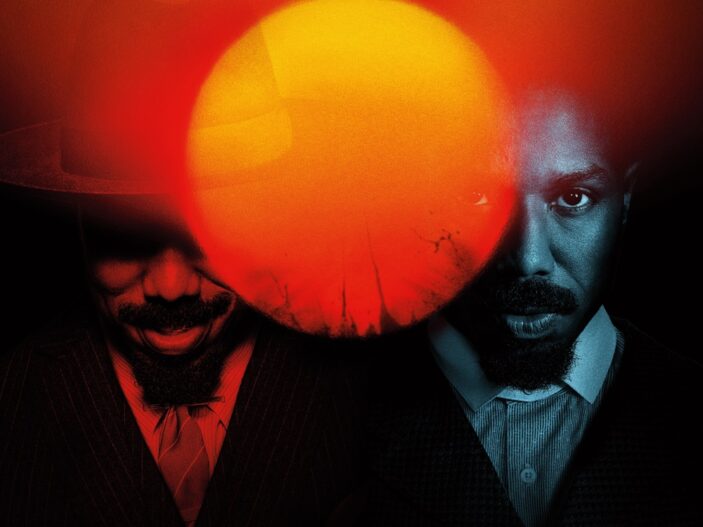Sinners is the first truly original movie we’ve seen from director Ryan Coogler, who has mostly worked with other material. In Fruitvale Station, he told the real-life story of the murder of Oscar Grant III. In Creed, he resuscitated a decades-spanning franchise with a fresh new vision. And with both Black Panther films, he depicted an empowered African nation through an Afro-futuristic lens. With Sinners, he is given a blank canvas to play with, and what has he decided to do? A lyrical tale about Southern hustlers and bloodsuckers without divorcing himself from the recurring themes of identity and legacy we have come to expect from his sensibilities.
Michael B. Jordan plays Smoke, a WWI ex-soldier who has returned to his hometown of Jim Crow and Prohibition-era Clarksdale with his brother Stack (also played by Jordan). The Smokestack twins have witnessed their fair share of bloodshed and carnage, from the German front line to the underworld of Capone-era Chicago. They both know the hustle, but it is through Jordan’s double act that each is imbued with distinctive eccentricities beyond merely color-coding them with red and blue hats and ties. Smoke is the more reserved and assertive one, while Stack is the snake charmer. “The best part about me is you,” Smoke says to his brother. One can’t exist without the other. They are inseparable.
In Clarksdale, we are introduced to an array of colorful characters. First is Sammie Moore (played by new talent Miles Caton), the cousin of the Smokestack twins and the son of a local preacher, hence the given nickname “Preacher Boy.” He wants to trade sermons for strings. Next, we meet a broken-down piano player, Delta Slim (Delroy Lindo), whom we find drunk and playing the harmonica for spare change outside the local train station. With Sammie’s guitar and Slim lured by a lineup of spirits, they are brought on board by the Smokestack twins to help open their juke club for everybody in town. It’s a place of harmony for our characters (though maybe not for the church) and for the audience. A place where the music played echoes in the past, present, and future. Don’t know what I mean by this? There’s a scene that will make that clear. Coogler’s ability to create a sense of elation through these moments in the first half showcases his talent as a director, and they are a real highlight to behold.
The stage is set. There is foreshadowing abound. There is horror. There is music. And there are, in case you didn’t pick up on it, vampires! When it comes to using vampires in films, the fun of their inclusion is how the filmmaker gets to pick and choose which parts of their lore stay and which can be discarded. By extension, there’s the question of whether the characters are even aware of what vampires actually are (The movie answers this question). For anybody expecting this movie to delve deeply into the lore, they may be sorely disappointed. That is not the legend this film focuses on. But that does not mean the movie is without its thrills and the menace that lurks in the shadows of Clarksdale. Once Jack O’Connell’s Remmick, a sneering vampiric Irish banjo player, arrives on the scene hoping to form his own immortal fellowship, our characters have to fight for their lives inside the juke club. What follows is a blood-soaked brawl for survival punctuated by, of all things, a rather mesmerizing Irish jig to “The Rocky Road to Dublin” that somehow feels very unnerving in the moment.
Sinners is sweaty and haunting, playing to the rhythm of a Southern gothic tale, illustrating how music is rooted in culture and what it truly means to be free from the sins of the past. And what a devilishly seductive ride it is! The first half reels you in with an enchanting cavalcade of characters from this small town in Mississippi, yet what remains most impressive is how Coogler manages to house all these different tones under one roof, especially when it decides to dip into more supernatural territories once the second half arrives, not just with the presence of vampires but also with the spirituality brought in by Smoke’s old flame Annie, played by Wunmi Mosaku. He risks diving into a genre we have yet to see from him, resulting in a bluesy bullet ballet of sin, sex, and spilled blood. Fortunately , he possesses the thematic prowess to prevent it from veering too hard into the exploitation genre territory (though there is plenty of Blaxploitation imagery throughout). Coogler lets the pulp sizzle and simmer between his messaging.
Two-time Oscar-winning composer Ludwig Göransson is working overtime on this score, which packs a bombastic, foot-stomping twang to the heat of the Mississippi setting, providing the backbone to this love letter to the blues musicians of the past. The cinematography by Autumn Durald Arkapaw captures the lush, feverish beauty of the rural South , painting the town and the cotton field in pretty pastels that stand in stark contrast to the darkness that eventually descends upon the characters- darkness lit only by flickering candlelight and fires ablaze.
Many lamentations have been made over Hollywood playing it safe and not taking chances on new original stories. Sinners is the antidote to this exact frustration. There might be some familiar flourishes, but the synthesis of all its influences turns it into something quite singular. It is fun, fresh, funny, sexy, and gives you plenty to think about. Now get out there and start supporting truly unique and terrifying visions.
Follow me on Letterboxd
Follow me on Xwitter
